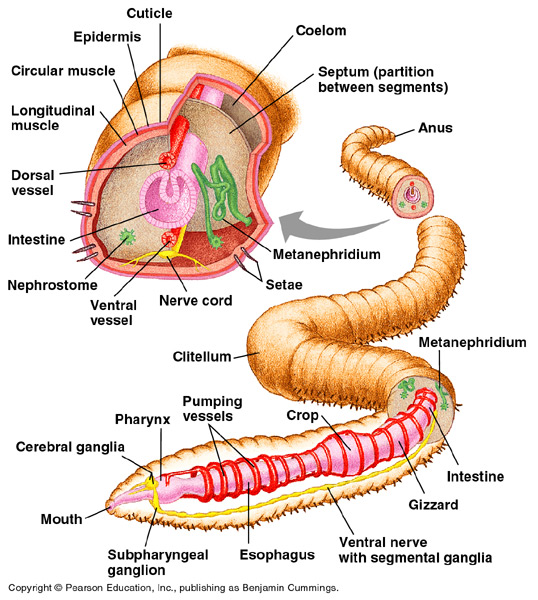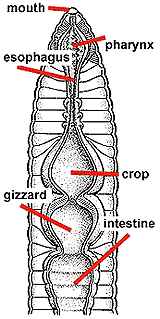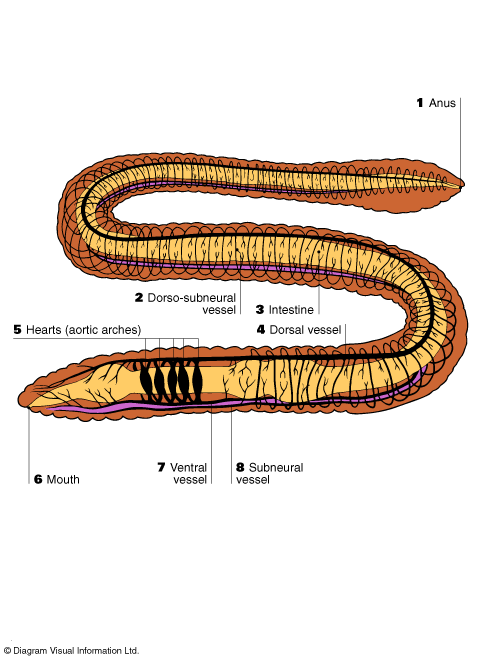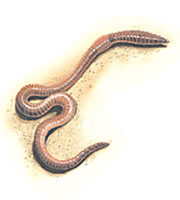| Earthworms | |
| Earthworms Help The Environment Earthworms are more than just fish bait. They are the main contributors to enriching and improving soil for plants, animals and even humans. Earthworms create tunnels in the soil by burrowing, which aerates the soil to allow air, water and nutrients to reach deep within the soil. Earthworms eat the soil which has organic matter such as decaying vegetation or leaves. Plants cannot use this organic matter directly. After organic matter is digested, the earthworm releases waste from their bodies called castings. Castings contain many nutrients that the plant can use. Some people even use earthworm castings as garden fertilizer.  | |
| Earthworm Anatomy 1. Segmented Body Earthworms are classified in the phylum Annelida or Annelids. Annelida in Latin means, “little rings.” The body of the earthworm is segmented which looks like many little rings joined or fused together. The earthworm is made of about 100-150 segments. The segmented body parts provide important structural functions. Segmentation can help the earthworm move. Each segment or section has muscles and bristles called setae. The bristles or setae help anchor and control the worm when moving through soil. The bristles hold a section of the worm firmly into the ground while the other part of the body protrudes forward. The earthworm uses segments to either contract or relax independently to cause the body to lengthen in one area or contract in other areas. Segmentation helps the worm to be flexible and strong in its movement. If each segment moved together without being independent, the earthworm would be stationary.  | |
| 2. Digestive System The digestive system is partitioned into many regions, each with a certain function. The digestive system consists of the pharynx, the esophagus, the crop, the intestine and the gizzard. Food such as soil enters the earthworm’s mouth where it is swallowed by the pharynx. Then the soil passes through the esophagus, which has calciferous glands that release calcium carbonate to rid the earthworm’s body of excess calcium. After it passes through the esophagus, the food moves into the crop where it is stored and then eventually moves into the gizzard. The gizzard uses stones that the earthworm eats to grind the food completely. The food moves into the intestines as gland cells in the intestine release fluids to aid in the digestive process. The intestinal wall contains blood vessels where the digested food is absorbed and transported to the rest of the body.  | |
| 3. Circulatory System Another important organ system is the circulatory system. The earthworm has a closed circulatory system. An earthworm circulates blood exclusively through vessels. There are three main vessels that supply the blood to organs within the earthworm. These vessels are the aortic arches, dorsal blood vessels, and ventral blood vessels. The aortic arches function like a human heart. There are five pairs of aortic arches, which have the responsibility of pumping blood into the dorsal and ventral blood vessels. The dorsal blood vessels are responsible for carrying blood to the front of the earthworm’s body. The ventral blood vessels are responsible for carrying blood to the back of the earthworm’s body.  | |
| 4. Respiratory System Earthworms do not have lungs. They breathe through their skin. Oxygen and carbon dioxide pass through the earthworm’s skin by diffusion. For diffusion to occur, the earthworm’s skin must be kept moist. Body fluid and mucous is released to keep its skin moist. Earthworms therefore, need to be in damp or moist soil. This is one reason why they usually surface at night when it is possibly cooler and the “evaporating potential of the air is low.” (www.amonline.net.au/factsheets/earthworms.htm) Earthworms have developed the ability to detect light even though they cannot see. They have tissue located at the earthworm’s head that is sensitive to light. These tissues enable an earthworm to detect light and not surface during the daytime where they could be affected by the sun.  | |
| Earthworm Reproduction Earthworms are hermaphrodites where each earthworm contains both male and female sex organs. The male and female sex organs can produce sperm and egg respectively in each earthworm. Although earthworms are hermaphrodites, most need a mate to reproduce. During mating, two worms line up inverted from each other so sperm can be exchanged. The earthworms each have two male openings and two sperm receptacles, which take in the sperm from another mate. The earthworms have a pair of ovaries that produce eggs. The clitellum will form a slime tube around it, which will fill with an albuminous fluid. The earthworm will move forward out of the slime tube. As the earthworm passes through the slime tube, the tube will pass over the female pore picking up eggs. The tube will continue to move down the earthworm and pass over the male pore called the spermatheca which has the stored sperm called the spermatozoa. The eggs will fertilize and the slime tube will close off as the worm moves completely out of the tube. The slime tube will form an “egg cocoon” and be put into the soil. The fertilized eggs will develop and become young worms.  |
Why do Earthworms surface after Rain
Earthworms laying on sidewalks or streets after a heavy spring rain has become commonplace, but why do they do this ... and could they be a travel hazard?
Researchers hypothesize several reasons why heavy rain storms bring crawlers out of their soil homes.
For years scientists seemed to think the only reason earthworms came to the soil surface after a good rain was to prevent drowning in their water-filled burrows.
"This is not true as earthworms breathe through their skins and actually require moisture in the soil to do so," said Dr. Chris Lowe, Lecturer in Waste and Environmental Management, University of Central Lancashire in Preston, United Kingdom.
Earthworms are unable to drown like a human would, and they can even survive several days fully submerged in water.
Soil experts now think earthworms surface during rain storms for migration purposes.
"It gives them an opportunity to move greater distances across the soil surface than they could do through soil," said Dr. Lowe. "They cannot do this when it is dry because of their moisture requirements."
Certain species of earthworms surface to mate, but only a few of the 4,400 existing species, making it unlikely that mating is a primary reason for widespread surfacing.
Another explanation involves rain drop vibrations on the soil surface sounding similar to predator vibrations, like that of moles. Earthworms often come to the surface to escape moles.
"Rain can set up vibrations on top of the soil like mole vibrations," said Professor Josef Gorres of the University of Vermont's Department of Plant and Soil Science. "Similar to how earthworms move upwards and out of the way when predator vibrations are felt, they could move in a similar way for rain vibrations."
Similarly, humans create vibrations when "fiddling" for bait earthworms.
To coax worms from their burrows, fishermen run a piece of steel or a hand saw across the top of a stake, which causes a rubbing sound to occur as the stake vibrates.
Earthworms are then moved to the surface, much to the fisherman's delight.
A Travel Hazard?
Although there are no reports of travel disruptions or injuries due to earthworms creating slick road conditions, some researchers haven't ruled out the possibility.
"I have not heard of earthworms causing slick conditions on sidewalks, but I can believe it might happen as they exude a mucous through their skin that may cause slippery conditions," said Dr. Lowe.
Can Drought Affect Worms?
It is essential that worms live in a moist environment, but during drought conditions, life is certainly more difficult for a worm.
"Earthworms dig deeper into the soil where it is moister when conditions are dry," said Mary Ann Bruns, Associate Professor of Agronomy/Soil Microbiology in the Department of Crop and Soil Sciences at Penn State. "They will do all they can to avoid extreme temperature fluctuations."

Earthworms are held up at the Mount Nelson Hotel's earthworm farm in Cape Town, South Africa in March of 2008. The earthworms are fed on kitchen waste from the hotel, which the worms process into fertilizer in their garden. (AP Photo/Schalk van Zuydam)
Earthworm Swarming
New research published in the journal Ethology revealed that earthworms form herds, swarming together to make "group decisions," as reported by BBC.
Earthworms use touch to communicate and interact, according to scientists who performed experiments on earthworm swarms outside of soil.
Research confirmed that social cues among earthworms influence behavior.
Exactly why earthworms have come to form herds is still being investigated, but it is possible that worms swarm to protect themselves. Protection from weather elements hasn't been ruled out.

No comments:
Post a Comment